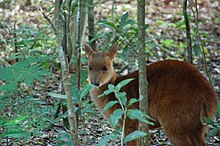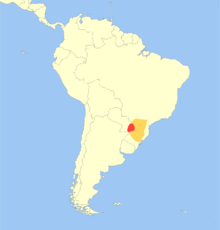

| Pygmy brocket | |
|---|---|

| |
| Scientific classification | |
| Domain: | Eukaryota |
| Kingdom: | Animalia |
| Phylum: | Chordata |
| Class: | Mammalia |
| Order: | Artiodactyla |
| Family: | Cervidae |
| Subfamily: | Capreolinae |
| Genus: | Mazama |
| Species: |
M. nana
|
| Binomial name | |
| Mazama nana (Hensel, 1872) | |

| |
| Pygmy brocket distribution. Extant Possibly extant | |
The pygmy brocket (Mazama nana) is a brocket deer species from South America.[2] It is found in southern Brazil, Argentina and Paraguay.[3] It is a small deer with short legs, weighing 15 to 20 kilograms (33 to 44 lb). It is reddish-brown in color.
This species is sometimes considered a subspecies of Mazama rufina.
The occurrence of hybrids between the two species was documented in captivity.[4]
| Mazama nana |
|
|---|---|